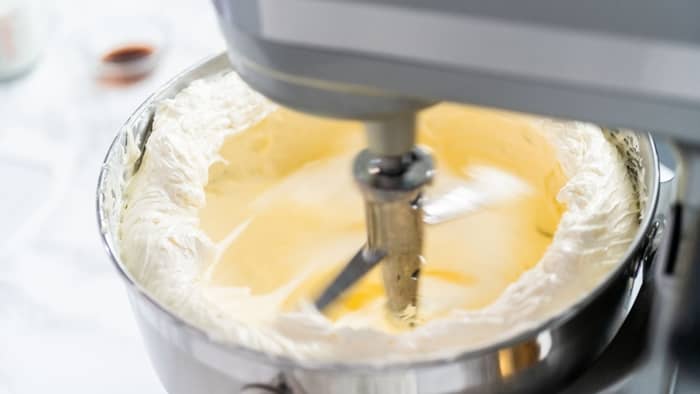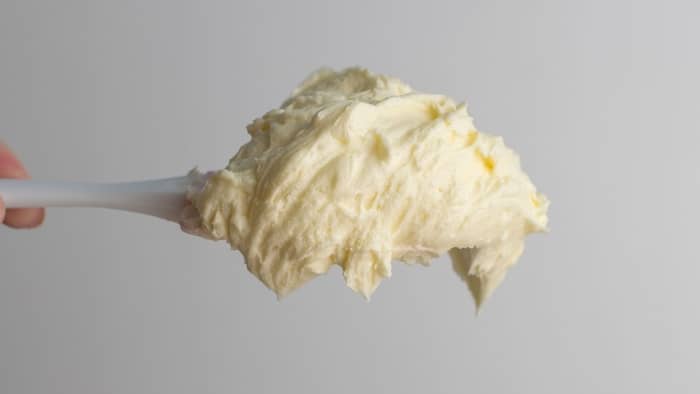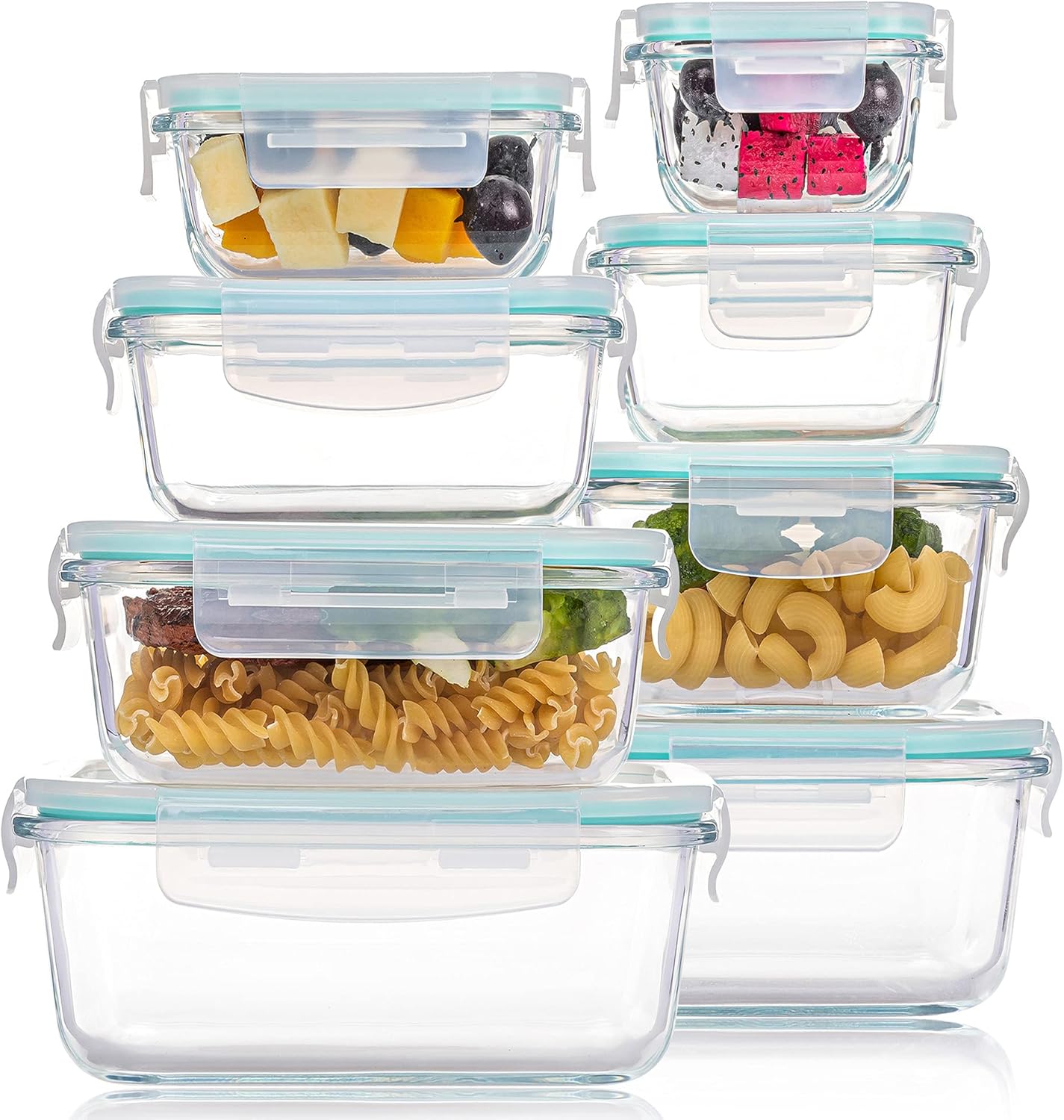Last Updated on January 31, 2023
Do you have to refrigerate frosting after opening it? Storing cakes and their garnishes may seem daunting, but today we will simplify the process!
We will go in-depth into exactly why you need to store frosting inside the fridge, how to do it properly, and what will ultimately affect the shelf life. So, are you ready to learn all about storing frosting? Let’s dive in!
What is Buttercream Frosting?
Buttercream frosting also referred to as butter icing, frosting, or buttercream, is a type of fluffy frosting made for decorating cakes and cupcakes. While it can be used in other ways, it often isn’t because of its overwhelming sweetness and decorative function.
This frosting is made using solid fat, powdered sugar, and extracts or essences. It can also contain milk or cream to help adjust the consistency a little. And of course, food coloring is often added to help convey a theme.
The type of fat used has a big effect on the ultimate shelf life of buttercream frosting. And, it will even answer the question “Do you need to refrigerate buttercream frosting.”
Real butter (salted or unsalted) can be used to give the frosting a rich flavor. However, it is expensive and has a very short shelf-life once opened and used. It also won’t make white frosting because of its own yellow color.
Then, you can also use shortening, which is made from plant oils and fats. It has a much more stable shelf life because of the preservatives and stabilizers it contains. But, it does create a fatty texture which bothers some people. Not to mention the flavor isn’t as good as that of butter.

Do You Need to Refrigerate Buttercream Frosting?
The short answer to this question is yes. However, as with everything related to food, it is often flexible depending on some factors. There are three main reasons you should store buttercream inside the fridge.
1. It contains perishable fats
Regardless of whether you are using real butter or shortening, both should be kept inside the fridge. While butter is more perishable than shortening, either can go off relatively quickly when kept at room temperature.
Furthermore, if you have included a softening ingredient like cream or milk, they will spoil very quickly too.
Now, the one thing that may prevent them from going off as quickly is because of the high sugar content in the frosting. Sugar is a preserving agent and will make the fats more shelf-stable. But unfortunately, not for an extremely long time.
2. The fat could melt
If you have ever had to transport frosted cupcakes or a cake on a hot summer’s day in a car with no air conditioning, you know exactly what we are talking about!
This reason only really applies in the summer or if you live in a very hot area. The fats you use to make buttercream frosting is solid at room temperature but can turn into a liquid when heated.
So, if you store the cupcakes in a warm area, the fat will soften and the frosting will start losing its shape. Eventually, especially if you have made layered cakes, the baked item will start to disfigure and fall apart. Trust us, it has happened to us before!
So, by storing the decorated item or plain frosting inside of the fridge, you will prevent it from splitting and melting away completely.
3. Mold growth
Bacteria thrive between the temperatures of 40-140ºF (4.4-60ºC). This range is also known as the temperature danger zone. And, because they also have moisture (fat) and food (sugar), they will reproduce rapidly in no time!
So, when thinking about “Do you need to refrigerate buttercream frosting? the answer is a non-thinker! If you don’t want moldy frosting, prevent it entirely by storing it inside the fridge.

Is Buttercream Shelf Stable? Understanding its Shelf Life & Storage
Here is a brief explanation for individuals who may be unfamiliar with the matter. The period during which a product can be stored without significant deterioration in quality, safety, and usefulness is referred to as its stable shelf life. As a result, a product with a stable shelf life has a predictable and extended length of time during which it remains in good condition and preserves its original attributes, such as flavor, texture, and nutritional content, but diminishes when stored properly.
As previously mentioned, this popular frosting is made from butter, powdered sugar, and milk or cream, and is known for its smooth and creamy texture, along with its versatility and delicious flavor. However, it is important to know at all times that buttercream is not shelf stable, which actually means that it cannot be stored for long periods without refrigeration.
One of the main reasons why buttercream is not shelf-stable is because of its high-fat content. Given that one of the main ingredients, butter, is of animal origin, it is prone to spoilage and rancidity. When combined with powdered sugar, milk or cream, and other ingredients, it creates an excellent habitat for bacteria and other microbes to develop. As a result, it becomes rapidly compromised and, among other things, it can develop an odd flavor or odor.
Another aspect that contributes to buttercream’s short shelf life is the lack of preservatives. Buttercream, unlike other frosting products, doesn’t contain any type of preservatives, which are typically used to lengthen the shelf life of food products. This implies that after making buttercream, it has to be consumed within a few days or stored in the refrigerator to prevent bacteria development.
Furthermore, it is extremely sensitive to temperature, which tells us that it can quickly melt much faster than you expect if left at room temperature. This can greatly affect its texture, consistency, and overall appearance.
In addition, buttercream has a neutral pH and lacks the acidity needed to prevent the growth of bacteria and other microorganisms and does not contain emulsifiers, which are added to products to improve their stability and shelf life.
So, do you have to refrigerate the frosting after opening it? Let’s find out below!
Shelf life Of Buttercream Frosting
Now, as you can see from the above-mentioned reasons, you can store buttercream at room temperature. But, we rather recommend storing it inside the fridge.
At room temperature, anywhere between 68-77ºF (20-25ºC), in ideal conditions, the frosting will last about 2 days before potentially starting to show signs of mold growth. But again, anything less than ideal will cause the shelf life to decrease drastically!
In the fridge, however, buttercream frosting can last effortlessly for up to a week! Just make sure that the fridge temperature is stable. You can even expect it to last up to 2 weeks!
And, if you want to store it long-term, you can keep it in the freezer for several months! And, it even thaws extremely well!
How to store buttercream frosting
There is only one effective way to store the frosting in the fridge. Place it inside an airtight container or bag and make sure the seal is tight. Store it inside a stable fridge away from any strong odors.
If you want to freeze it, you can follow the same steps. Easy enough, right?
How to tell if buttercream frosting has gone bad?
There are a couple of obvious signs to tell whether or not your buttercream frosting is still good. The first is visible signs of mold. The mold will appear in shades of white, black, blue, and green. Unfortunately, depending on the severity of the growth, it isn’t salvageable.
You can also look out for any textural changes. If the frosting starts going grainy (once it is close to the estimated expiry date) the bonds of the ingredients have likely started to deteriorate.
Another extremely tell-tale sign is a rancid odor or flavor. Because you use dairy products and fats, they go rancid after a while. This flavor or odor will be slightly sour and tart. You should immediately discard the frosting.
How Long Can Frosting Sit Out? Maximizing Freshness
Buttercream, as well as all other frostings, shouldn’t be left out of the refrigerator for an extended period due to the potential risk of foodborne illness. The frosting is frequently made using different dairy products, eggs, and sugar, all of which can encourage the growth of harmful microorganisms if not stored at the right temperature. The risk of foodborne disease increases if food is left out at room temperature for any reason, which provides an excellent habitat for bacteria to flourish.
Furthermore, if frosting is left out for too long, it can soon get contaminated, and it is impossible to determine whether it has gotten contaminated just by looking at the eye. Consumption of contaminated frosting can result in food poisoning, which can cause symptoms such as nausea, vomiting, diarrhea, and stomach cramps.
Tips
- When everything is added and subtracted, it can sit at room temperature for no more than 2 hours before it becomes unsafe to consume. If you don’t intend to use it within two hours, you have two choices: don’t prepare it at all or put it in the refrigerator. In any case, it is better to prolong making it than to wait for hours in the emergency room.
- In addition, if you have already decorated a cake with frosting and it’s been sitting out for more than 2 hours, it is advisable to toss it away and start again.
- Also, if it is left in the sun or near a heat source, it is best to throw it away immediately. Either way, anything beats suffering the excruciating pain that comes from eating food that has gone bad.
- To recap everything you have learned so far, although frosting can be left out for up to 2 hours, it is recommended to keep it refrigerated to maintain food safety and prevent spoiling.
The Fridge Factor: How Long Does Frosting Last in The Fridge?
In a nutshell, frosting can last for an extended period if it is stored properly in the refrigerator. How long it will last varies depending on the type of frosting and the ingredients used, but in most cases, it can be considered safe for consumption between 5 days and 2 weeks. During this period, you should neither poison yourself nor endanger your health in any other way.
Now we will discuss it in further depth to make it easier for you to understand.
Buttercream frosting, for example, if you remember is made with butter and powdered sugar, and considering the ingredients used can be kept in the refrigerator for up to two weeks if stored in an airtight container.
Unlike it, cream cheese frosting is made from cream cheese and powdered sugar, and its shelf life in the refrigerator is shorter than about 7-10 days. This is due to the increased moisture content of cream cheese, which makes it more prone to spoilage compared to buttercream.
As you probably already know, Royal icing is made from powdered sugar, egg whites, and lemon juice, which create a hard, glossy finish that is perfect for decorating all kinds of baked goods you can imagine. Thanks to its high sugar content and low moisture content, which helps prevent the development of bacteria and other microorganisms, it is less susceptible to spoilage than other types of frosting, such as butter or cream cheese frosting. This is precisely why it can stay in the refrigerator for at least 3 weeks without changing its texture and quality.
Ganache frosting for example can be stored in the refrigerator for up to 2 weeks because it contains a high percentage of chocolate and heavy cream. The thing is the chocolate functions as a preservative, preventing the growth of potential pathogens and other microbes that might lead to spoilage. Similarly, lactic acid, found in heavy cream, works as a natural preservative in ganache frosting.
That’s it, now you know the answer to the question “do you have to refrigerate frosting after opening”.
Final Words
As you can see, the answer to, “Do you have to refrigerate frosting after opening?” is very simple. To help extend the shelf life considerably, rather store it inside the fridge! If you still have any questions for us, feel free to ask us in the comments below! And, let us know if there is anything else you would like to learn about!
FAQs
How do you store a cake with buttercream frosting?
The best way to store cake with buttercream frosting is inside the fridge. Especially if you won't be finishing the cake and frosting within a day or two. Wrap the entire cake in plastic wrap or place it inside a cake container. Then, place it in a fridge with stable temperatures.
Does buttercream frosting spoil?
Buttercream frosting can go bad because of the fat and dairy products it contains. Real butter, milk, and cream will make the frosting spoil much quicker than plant-based shortening.
How long does cake with buttercream last?
Buttercream will only last a day or two at room temperature - less if it is hot outside. Inside of the fridge, it can last up to a week or two. And, if frozen, it will last several months.
Does frosting need to be refrigerated after opening?
If you buy store-bough pre-made frosting, you will have to store it in the fridge once it has been opened. If the airtight seal has been broken, bacteria will immediately start to multiply. The fridge is the best way to prevent this from happening.

Lindy Van Schalkwyk is a culinary specialist with a background in Advanced Cooking, Advanced Pâtisserie, Media Communications and Nutrition. She has gained invaluable experience in the culinary industry having worked in some of the top restaurants in Africa in 2016 and 2017. Her expertise in nutrition has enabled her to develop recipes for special dietary needs. In 2018, Lindy began working in the Food Media industry, focusing on recipe development, recipe writing, food writing and food styling.


